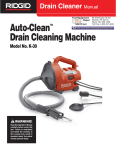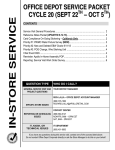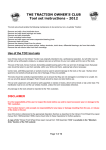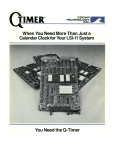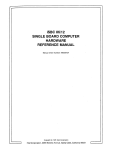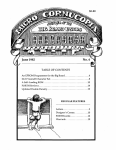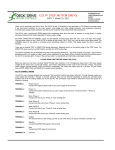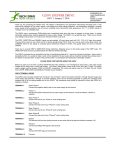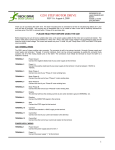Download user manual (Acrobat)
Transcript
LOBO Drives Model LX80 Expansion Interface i TABLE OF CONTENTS SECTION DESCRIPTION PAGE SECTION I 1.1 Introduction 1.2 System Description 1-1 1-1 1-1 SECTION II - UNPACKING THE INTERFACE 2.1 Visual Inspection 2.2 Unpacking the Expansion Interface 2.3 Unpacking Disk Drives 2-1 2-1 2-1 2-2 SECTION III - SETTING UP THE SYSTEM 3-1 SECTION IV - TROUBLESHOOTING HINTS 4-1 SECTION V - DISKETTE CARE 5-1 SECTION VI - TECHNICAL DATA 6.1 Memory Map 6.2 Input/Output Port Map 6.3 Interface Specifications 6.4 Installing Your Own 16K RAM 6.5 Configuring the Alternate ROM Jumper Plug 6.6 Configuring the RS-232 Jumper Plugs 6.7 Modifying Power Supply for 235VAC/50HZ or 117VAC/60HZ 6.8 Keyboard Power Cable Installation 6-1 6-1 6-1 6-2 6-4 6-4 6-5 6-7 6-9 LIST OF ILLUSTRATIONS FIGURE 1-1 3-1 3-2 3-3 6-1 6-2 TITLE LX80 Expansion Interface Peripheral Connections Keyboard Flat Cable Installation Mini and 8" Floppy Disk Connections Drive 0 Configuration Switches AC Power Voltage Modifications Keyboard Power Cable Installation ii PAGE 1-2 3-1 3-3 3-4 6-8 6-9 SECTION I INTRODUCTION 1.1 INTRODUCTION The LOBO DRIVES LX80 Expansion Interface greatly increases the power and capabilities of your Radio Shack Level II TRS-80 microcomputer. When properly installed, it allows you to connect a wide variety of peripheral devices (printers, disk drives, communication modems, voice synthesizers, etc.) as well as to increase the amount of Random Access Memory (RAM). The increased RAM will be needed to hold longer programs and process more data quickly. 1.2 SYSTEM DESCRIPTION The Model LX80 Expansion Interface is designed for the serious user who wants to improve the performance and capabilities of the TRS-80 computer. Incorporating many of the features of Radio Shack's expansion interface, the Model LX80 offers many improved and new features. It enhances system performance by expanding disk storage capabilities to 40 million bytes, adding a second serial port, and facilities for 32K of RAM. A switch permits overriding the keyboard ROM for booting in diagnostics and customized operating systems. One of the outstanding features of the Model LX80 Expansion Interface is its disk memory expansion capabilities The interface can support up to four (4) of any of the following disk drives, in any combination, providing a maximum of 40 million bytes of storage on your TRS-80 computer: a. 5.25-inch Mini Floppies, single or double density, single or double sided. b. 8-inch standard floppies, single/double density, single/double sided. c. LOBO Model 1850T Dual Fixed/Floppy Disk Drives, 5 or 10 Megabyte fixed, up to 1.6 megabytes floppy (unformatted). 1-1 Connections between the disk drives and the expansion interface are conveniently located on the rear and side panels. (See Figure 1 -1.) There is a separate bidirectional parallel port exclusively for connecting hard disk drives. Other features include: a parallel port that functions like the Centronics printer port on the Radio Shack interface; a screen printer port; two programmable bidirectional serial ports; and a crystal controlled "Real Time" clock. Figure 1-1. LX80 Expansion Interface Peripheral Connections. 1-2 SECTION II UNPACKING THE INTERFACE 2.1 VISUAL INSPECTION Before you open the shipping container, visually inspect it for evidence of shipping damage or mishandling, If such damage is present, a report should be filed with the carrier as soon as possible. Do not remove or operate the expansion interface if any possibility of damage is evident. 2.2 UNPACKING THE EXPANSION INTERFACE Carefully unpack the expansion interface and proceed as follows: a. Check the tag or label on the interface to verify you have received the options you ordered: 16K or 32K of RAM; Dual Serial Communications ports; keyboard power cable; 230 VAC/50Hz power supply (includes cable). b. Check that you have a 6-inch, 40-conductor keyboard flat cable. c. Check that you have a diskette containing the Disk Operating System (DOS) software. CAUTION Be very careful when handling the diskette. READ SECTION V DISKETTE CARE before handling any diskettes. 2-1 2.3 UNPACKING DISK DRIVES Any disk drives you may have ordered from LOBO DRIVES will be packaged separately. Carefully inspect and unpack the drives as described in paragraphs 2.1 and 2.2. Check that you have the correct long flat data cable for your type of drive. Contact your local dealer or LOBO DRIVES if any item(s) is missing. a. Mini Floppies - require long 34-conductor, five connector cable. b. Dual 8-inch Floppies - requires a long 50-conductor, two connector cable (three connectors if you have two dual-drive units.) c. Model 1850T - same as Dual 8-inch Floppies, plus disk controller unit, power supply and special cable assemblies. 2-2 SECTION III SETTING UP THE SYSTEM Find a space large enough to hold all the components of your system, plus adequate work space. Be sure you will have enough AC power outlets to run all the components of your system. LOBO DRIVES recommends the use of a fused, switched power distribution box. To set up your system, proceed as follows: 1. For safety, be sure the entire system is OFF and everything is unplugged from the AC power line. 2. Referring to Figure 3-1, plug one end of the 6-inch keyboard flat cable onto the connector visible through the slot in the bottom of the interface. NOTE The colored wire at the edge of the flat cable should be on the right side when looking at the front of the interface. Figure 3-1. Keyboard Flat Cable Installation. 3-1 3. Remove the protective plastic connector cover from the back of the keyboard. Plug the free end of the interface cable onto the exposed connector Do not attempt to connect the interface to a keyboard with a DIN cable modification Do not use a "Buffered" or "Shielded" keyboard cable, 4. Place the video monitor on top of the interface. Plug its DIN cable into the keyboard VIDEO socket. NOTE If your interface has no keyboard power cable, skip step 5 and proceed to step 6, 5. Identify the five-conductor DIN cable coming from the rear of the interface Feed the cable under the interface and plug it into the keyboard's POWER socket. NOTE You no longer need the keyboard's old power module, The interface will now supply the correct keyboard power for 230 VAC installations and the keyboard will run cooler than before. Proceed to step 8, 6. Plug the keyboard's original power supply module into the POWER socket on the back of the keyboard. 7 Place power module off to the side. It car cause the picture to squirm if placed too close to the back of the video monitor. 8. If you have purchased floppy drives place them to one side of the interface and plug them into the flat cable as shown in Figure 3-2. 3-2 Figure 3-2. Mini and 8" Floppy Disk Connections NOTE Check the drive part numbers. Only one drive can contain termination resistors, and that drive must be the furthest from the interface, Any unused connectors must be at the END of the cable. 9. If you are installing standard 8-inch floppies, refer to Figure 3-2 and connect the drives using the supplied flat cable. If you are using one dual-drive unit, then connection is simple. This unit should be labeled DS1/DS2/TERMINATORS. If you are using two dual-drive units, then you must be sure to have a double connector cable and two specially configured dual-drive units. The first unit on the cable must be DS1/DS2/NO-TERMINATORS while the second must be DS3/DS4/TERMINATORS. 3-3 10. If installing a hard disk drive, refer to its own information sheet and connect to the interface. 11. You must set the "drive configuration" switches on the rear panel of the interface. These switches tell the interface what to do when you power-up or reset the system. Normally, you want the interface to load the operating system software from your fastest disk drive (this will be DRIVE 0). Refer to Figure 3-3 for the location of the DRIVE 0 select switches. If you have an 8" floppy drive or a hard disk that you want to be DRIVE 0 then you must have an 8" diskette or a hard disk that contains the disk operating system software. If your only copy of the operating system is on a mini diskette, they you must select DRIVE 0 as a mini floppy and proceed as if it were the only drive available to you. Later, you may use the disk operating system commands to copy the mini disk data onto an 8" floppy or hard disk. Figure 3-3. DRIVE 0 Configuration Switches. 3-4 NOTE Selection of DRIVE 1, DRIVE 2, DRIVE 3, . . . depends upon the operating system software. Refer to the appropriate section in the disk operating system manual. 12. Place the interface's NML-ALT switch in the NML position. 13. Turn all of the units OFF. Plug everything into the AC line (or into the power distributor box), Turn everything ON following this sequence: a. Turn ON video monitor. b. Turn ON drives, (Wait 20 seconds if you have a hard disk drive.) c. Turn ON interface. d. Turn ON keyboard. e. If DRIVE 0 is a floppy drive, refer to DISKETTE CARE and insert the system diskette. f. Press RESET button on keyboard to "boot in" and run the disk operating system software. 14. At this point, your computer system should be operational. A message on the video display should indicate that the system is working and awaiting further keyboard commands. Turn to the disk operating system manual and learn how to use your new system. 15. To turn OFF the system, follow this sequence: a. Close any files you may have opened. Wait for all disk activity to stop. b. Remove all diskettes from all floppy drives. c. Turn OFF everything, sequence doesn't really matter. 3-5 SECTION IV TROUBLESHOOTING HINTS Due to the complex nature of the circuitry utilized in the Model LX80 Expansion Interface, user troubleshooting must logically be limited to a few simple checks. Should an Expansion Interface malfunction persist after the hints provided in this section are followed, the user should refer the problem to the nearest LOBO DRIVES dealer or contact LOBO DRIVES directly. Here are a few hints to help you get your system running: a. Double-check all connections. Be sure everything is plugged in and turned ON. b. Check each unit's fuse. Replace defective fuses. c. Turn up video monitor brightness to verify its operation. d. Recheck cable orientations against the Figures 3-1 and 3-2. NOTE One reversed cable can disable several components. A reversed cable can cause a floppy drive to erase diskettes. e. Be sure the NML-ALT switch is in the NML (normal) position. f. Check the drive serial number. Be sure you have selected the correct DRIVE 0 with the drive configuration switches (see Figure 3-3). 4-1 g. Check that DRIVE 0 has an operating system diskette in it. h. Try turning the keyboard OFF for a few seconds, then back to ON. i. Try setting DRIVE 0 to be "NO DRIVE" (both switches off, see Figure 3-3). Now, press the keyboard reset button, There will be a 1/2 second pause and then MEMORY SIZE? will appear on the screen (you are in BASIC LEVEL II). If this message does not appear, or if there is no momentary pause, there is a problem with the interface or the interface/ keyboard cable. WARNING The solid state devices contained in the Expansion Interface are sensitive to static electricity charges too small for you to feel. Technicians work on them under special anti-static conditions with grounding straps and other equipment not normally available to user/owners. Unless you are a trained computer technician, refer all service to your local LOBO DRIVES dealer. 4-2 SECTION V DISKETTE CARE Diskettes are precision recording media. Handle them very carefully to get maximum life from each one. In general, follow the special handling precautions used with both tape cassettes and high fidelity records and the instructions below: a. Keep the diskette in its storage envelope whenever it is not in one of the drives. b. Keep diskettes away from magnetic fields (transformers, AC motors, magnets, etc.). Strong magnetic fields will destroy data on the diskettes. c. Handle the diskette by the jacket only. Don't touch any of the exposed surfaces. Don't try to wipe or clean the diskette surface; you may scratch it and destroy data. d. Keep the diskette away from heat and direct sunlight. e. Avoid contamination of the diskette with cigarette ashes, dust, or other particles. f. Use only felt-tip pens to write on diskette labels. g. Insert the diskette into a drive carefully. Never force the door closed. Gently remove and reinsert the diskette. 5-1 h. Remove the diskette from the drive before turning the power ON or OFF. i. Special "write protect" stickers may be placed over the write protect notch in the edge of the diskette to protect your data, When a sticker covers the notch of a mini diskette, it becomes impossible for the computer to add or change information stored on the diskette. The reverse is true for an 8-inch diskette . . . remove the sticker to write protect the data. 5-2 SECTION VI TECHNICAL DATA 6.1 MEMORY MAP ADDRESS USE 0000H-2FFFH 3000H- 33FFH 37E0H-37E3H 37E8H-37EBH alternate ROMs if selected by the switch disk boot and I/O ROM read for interrupt code (clears RTC interrupt) read for line printer and hard disk status, write for line print output first 16K RAM add-on second 16K RAM add-on 8000H-BFFFH C000H-FFFFH 6.2 INPUT/OUTPUT PORT MAP PORT E0 E1 E2 E3 E4 E5 E6 E7 E8 E9 EA EB INPUT OUTPUT hard disk data floppy FIFO data FIFO counter dip switch 1791 status register 1791 track register 1791 sector register 1791 data register SIO data A SIO data B SIO status A SIO status B hard disk data floppy FIFO data FIFO mode (0-read, 1-write) floppy select and modes 1791 command register 1791 track register 1791 sector register 1791 data register SIO data A SIO data B SIO command A SIO command B 6-1 PORT EC ED EE EF FC FD FE FF INPUT OUTPUT --------- BAUD rate A BAUD rate B -----reset boot logic 6.3 INTERFACE SPECIFICATIONS a. Outside dimensions: Height Width Depth 2.8" (7 cm) 19.0" (48 cm) 11.8" (30 cm) b. Power Requirements: 117VAC 60HZ or 235VAC 50HZ (internally jumpered) Three wire (grounded) power cord 40 watts c. Maximum number of disk drives: Depends upon software, hardware can run four single or double-sided mini floppies, plus four single or double-sided 8" floppies, plus any number of hard disk drives (limited only by the type of hard disk drives used). 6-2 d. Disk storage (maximum formatted, depends upon software): SA-400 (single sided mini floppy drive) single density 89K bytes double density 161K bytes SA-450 (double-sided mini floppy drive) single density 179K bytes double density 322K bytes SA-800 (single sided 8" floppy drive) single density 335K bytes double density 611K bytes SA-850 (double sided 8" floppy drive) single density 670K bytes double density 1,222K bytes e. Real time clock (RTC) Interrupts CPU every 25 milliseconds, crystal accuracy f. Two RS-232 serial channels (both identical): Controller Zilog's Z80-SIO/2 Serial formats: ASYNC, SYNC (with CRC), HDLC & SDLC Baud rates: programmable, 12.5 to 316.8K Cable configuration selected by jumper plugs g. Alternate ROMs: Replace keyboard ROMs (0000H-2FFFH) by toggling switch Three 24-pin sockets are configured by a jumper plug to accept one type of ROM: 2708s, 2716s, or 2732s Alternate-ROM code runs about 30% slower than in RAM h. Expansion port: A duplicate of the keyboard port, except for no +5V power on pin 37, i. Parallel printer port: Talks to a Centronics-like printer. 6-3 6.4 INSTALLING YOUR OWN 16K RAM a. It is easy for you to install your own RAM chips that you can purchase as an upgrade kit. Simply UNPLUG THE INTERFACE AC CORD, remove the two cover screws, and carefully lift the cover. b. The first eight RAM chips will go into the bottom row of sockets at the right side of the circuit board. The second set of eight will go into the upper row. One at a time, push the new chips into their sockets. Be sure that the orientation notch points toward the top of the circuit board (the way all the other chips go). Be very careful not to bend any of the pins. After inserting all of the chips, double check your work, then reassemble the cabinet. c. Now, load in BASIC and do a PRINT MEM. Do you have 16,384 more bytes than before? 6.5 CONFIGURING THE ALTERNATE ROM JUMPER PLUG a. To use the alternate ROM sockets, first open the cover: UNPLUG THE INTERFACE AC CORD, remove the two screws, and carefully lift the cover. Remove the 16-pin jumper plug from the circuit board (just above the ROM sockets, mounted sideways). Refer to the guides below and solder jumpers across the removed plug. Don't melt the plastic. Reinsert the plug (pin 1 is oriented toward the upper-right corner), insert your ROMs into the three sockets (the leftmost socket is at address 0000H) and reassemble the cabinet. NOTE AMP brand sockets are Mil-spec devices that sometimes require puller tools to remove the ICs. b. Jumpering for 2308s, 2708s (+5v, -5v, +12v): Connect pins 1-4, 2-3, 9-19, 12-13-14-15 6-4 c. Jumpering for 2316E, 2716s, (+5v only): Connect pins 1-5, 2-4, 3-19, 12-13-14-16 d. Jumpering for 2332s, 2732s, (+5v only): Connect pins 1-6, 2-5, 3-10, 4-12-13-14 e. Here is a description of the ROM jumper plug pins: 1 decoder input B 2 decoder input A 3 A10 4 A11 5 A12 6 A13 7 not used 8 ground 16 +5 volts 15 -5 volts 14 pin 21 of ROM A 13 pin 21 of ROM B 12 pin 21 of ROM C 11 not used 10 pin 19 of ROM A, B, C 9 +12 volts 6.6 CONFIGURING THE RS-232 JUMPER PLUGS a. To configure the RS-232 channels for your particular serial devices, you must open the interface cabinet (UNPLUG THE AC CORD). Remove the two jumper plugs near the serial connectors. Refer to the guides below and solder jumpers across the plug so that all the signals go to the correct places, depending upon your particular serial device. Don't melt the plastic. Reinsert the plugs (pin 1 is oriented toward the lower left corner) and reassemble the cabinet. b. Here is a description of the SERIAL jumper plug pins: Pins 1 and 7 of the DB-25S are permanently grounded. All signals are standard RS-232 level. 6-5 1 2 3 4 5 6 7 8 9 10 11 12 +12 volts TxD (transmit data) TxC (transmit clock) RTS (request to send) DTR (data terminal ready) RxD (receive data) RxC (receive clock) CTS (clear to send) DOD (data carrier detect) -12 volts not used not used 24 23 22 21 20 19 18 17 16 15 14 13 not used DB-25S pin 9 DB-25S pin 24 DB-25S pin 4 DB-25S pin 20 DB-25S pin 3 DB-25S pin 17 DB-25S pin 5 DB-25S pin 8 DB-25S pin 6 not used not used TxD, TxC, RTS, and DTR signals leave the interface. RxD, RxC, CTS, and DCD signals enter the interface. c. TxC is the transmitter clock. It is generated by the baud rate generator and can be sent out of the interface (usually on DB-25S, pin 24) if the external drive needs a clock. d. RxC is the receiver clock. It is brought in from the external device (usually on DB-25S, pin 17) and is used to clock the SIO receiver. If there is no external clock, it is customary to connect RxC to TxC so that the receiver and transmitter run at the same speed. e. After configuring the jumpers, the SIO controller must be programmed to communicate in the correct mode(s). This must be done by the serial communications program. Explanation of this programming is beyond the scope of the Interface User's Manual, so the user is directed to Zilog's Z80-SIO/2 Product Specification data book. f. Programming the TxC clock rates is simple. Simply send the correct code to port EC (for port A) or ED (for port B): 6-6 CLOCK 800 1200 1760 2152.3 2400 4800 9600 19,200 CODE 00H 01H 02H 03H 04H 05H 06H 07H CLOCK 28.8K 32.081K 38.4K 57.6K 76.8K 115.2K 153.6K 316.8K CODE 08H 09H 0AH 0BH 0CH 0DH 0EH 0FH Note that the SIO controller can divide these clocks by 1, 16 or 64, giving all of the popular baud rates. 6.7 MODIFYING POWER SUPPLY FOR 235VAC/50HZ or 117VAC/60HZ a. To change the interface's voltage requirements, first open the interface cover: UNPLUG THE INTERFACE, remove the two screws, and carefully lift the cover. b. If you are modifying for 235VAC use, refer to Figure 6-1a: i. Remove the two transient suppression capacitors from the ON/OFF switch. ii. The neon lamp in the switch does not operate properly at 235VAC so disconnect the wires from the bottom lug of the ON/OFF switch and fasten the wires together with a wire nut or similar device. If you really want the neon bulb to light, connect a 100K Ohm resistor between the wire nut and the now bare bottom lug of the switch. iii. Rewire the power supply transformer so that power comes in on pins 1 & 4. Pins 2 & 3 must be connected together. iv. Install a 3/8 ampere fuse. v. Proceed to SECTION 6.8 and install the keyboard power cable, which allows your keyboard to run from the interface's 235VAC supply. 6-7 c. If you are modifying for 117VAC, use, refer to Figure 6-1b: i. Connect the cold (white wire) side of the AC input power to the bottom lug of the ON/OFF switch. This restores the neon lamp operation. ii. Rewire the power supply transformer so that power comes in on pins 1 & 4. Pins 1 & 3 and pins 2 & 4 must be connected together. iii. If you choose to install the transient suppression capacitors, connect one 0.1uf 1000V ceramic disc from the cold (white wire) side of the AC input power to ground. Connect a second 0.1uf capacitor from the hot (black wire) side of the AC input power to ground. Be sure to insulate the capacitor leads. iv. Install a 3/4 ampere fuse. v. Do not remove the keyboard power cable. Though not essential for keyboard operation at 117VAC it still lets your keyboard run cooler. vi. Reassemble the cabinet and test the interface. Figure 6-1. AC Power Voltage Modifications 6-8 Figure 6-2. Keyboard Power Cable Installation 6.8 KEYBOARD POWER CABLE INSTALLATION a. To install the keyboard power cable, first obtain the following parts: 1) DIN plug 2) Four-conductor round cable (stranded wire, 20AWG). 3) Cable strain relief (HEYCO) that fits the hole in the rear panel of the interface. b. Refer to Figure 6-2a and assemble the DIN plug end of the cable. This cable should be at least 30" (75cm) long. Keep careful record of which wire goes to which DIN plug pin. 6-9 c. Open the interface: UNPLUG THE AC CORD. Remove the two screws and carefully lift the cover. d. Pass the loose end of the cable through the KBD POWER hole and into the rear of the interface cabinet. Feed in just enough wire so that the cable will reach the furthest corner of the power supply. Force the strain relief over the cable and into the cabinet hole. e. Refer to Figure 6-2b and solder the cable's wires to the indicated places on the top side of the power supply's circuit board. f. Reassemble the cabinet. Unplug and put aside the old power module that had powered the keyboard. Plug the NEW power cable into the POWER socket in the back of the keyboard. Push the keyboard switch ON (and leave it ON because the interface now controls keyboard power). g. Test the entire system to verify correct wiring. 6-10


























